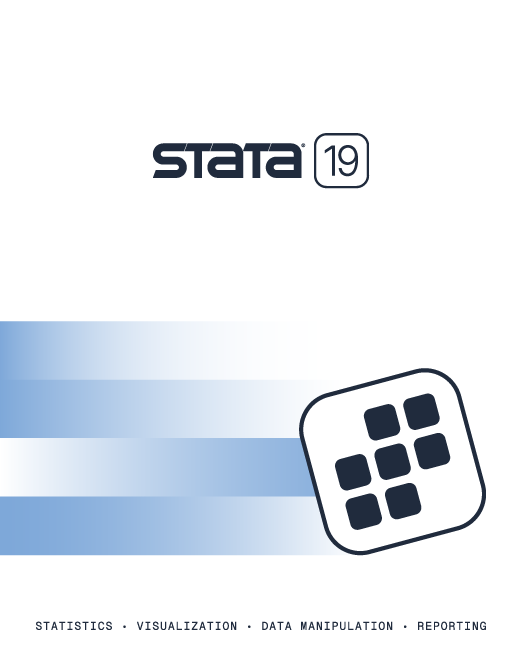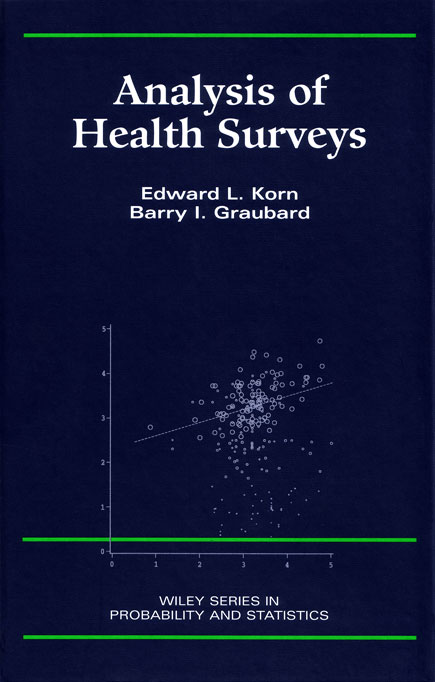

2025 Stata Conference • Nashville, TN • 31 July–01 August
Analysis of Health Surveys |
||||||||||||||||||||||||||||||||||||
 Click to enlarge See the back cover |

As an Amazon Associate, StataCorp earns a small referral credit from
qualifying purchases made from affiliate links on our site.
eBook not available for this title
eBook not available for this title |
|
||||||||||||||||||||||||||||||||||
Comment from the Stata technical groupThis book relishes answering those thorny “how to” questions that emerge when analyzing data from a survey administered to a sample with a complex design. Although the examples and some of the topics pertain to biostatistical issues, this is a book that would interest any researcher doing applied work with survey data. Analysis of Health Surveys answers many of the most frequently asked questions posed by researchers analyzing real survey data. For instance, there is a whole chapter on analyzing data from multiple surveys, a special section on strata with one sampled primary sampling unit, and another section dedicated to making recommendations for using sample weights. This book is filled with examples of how to estimate and interpret various types of regression models for cross-sectional and longitudinal data. The fact that this book contains an appendix that briefly describes the sample designs of the surveys used in the examples of the book illustrates how instructive the “hands on” aspects of this text are. This book does not shy away from derivations. There is a very nice introduction to survey methodology, and claims are treated rigorously throughout. However, the claims and supporting arguments are of great practical use. |
||||||||||||||||||||||||||||||||||||
Table of contentsView table of contents >> Preface
1. Introduction
1.1 Why Analyze Health Surveys?
1.2 Conducting a Large-scale Health Survey: The Third National Health and Nutrition Examination Survey 1.3 Common Types of Health Surveys and Their Sample Designs 1.4 Sampling Frames 1.5 The Complexity of Analyzing Survey Data: A Preview 2. Basic Survey Methodology
2.1 Introduction
2.2 Single-Stage Sampling Plans 2.3 Multistage Sampling 2.4 Variance Estimation of Functions of Estimators: Linearization 2.5 Replication Methods of Variance Estimation: The Jackknife, Balanced Half-Sample Replication, and the Bootstrap 2.6 Using Auxiliary Population Information to Analyze Survey Data: Poststratification, and Ratio and Regression Estimators 2.7 Nonsampling Errors: Nonresponse, Sampling Frame Undercoverage, and Measurement Error 2.8 Some Other Types of Surveys 2.9 Notes 2.10 Problems 3. Statistical Analysis with Survey Data
3.1 Introduction
3.2 Inference for a Single Variable: Means, Measures of Dispersion, Proportions, Totals, and Percentiles 3.3 Comparisons Between Two Means: T-Tests and Tests of Proportions 3.4 Scatterplots 3.5 Linear Regression and Analysis of Variance 3.6 Logistic Regression: Analysis of Categorical Outcomes 3.7 Survival Analysis: Analysis of Cohort Data 3.8 Predictive Margins (Direct Standardization) 3.9 Analyses Restricted to Subpopulations 3.10 Other Types of Analyses 3.11 Notes 3.12 Problems 4. Sample Weights and Imputation
4.1 Introduction
4.2 Components of Sample Weights 4.3 Weighted Versus Unweighted Estimates of Population Parameters 4.4 The Inefficiency of Using Sample Weights 4.5 Modeling the Survey Design — An Alternative to Weighted Estimation 4.6 Summary of Recommendations for Utilizing Sample Weights 4.7 Imputation for Missing Data 4.8 Notes 4.9 Problems 5. Additional Issues in Variance Estimation
5.1 Introduction
5.2 Limited Degrees of Freedom for Variance Estimation 5.3 Strata with One Sampled Primary Sampling Unit 5.4 Variance Estimation for Subpopulations 5.5 Variance Estimation with Imputed Values 5.6 Generalized Variance Functions 5.7 Variance Estimation for Superpopulation Inference 5.8 Notes 5.9 Problems 6. Cross-Sectional Analyses
6.1 Introduction
6.2 Identifying Individuals at High Risk for Snuff Use 6.3 Blood Lead Levels and Blood Pressure 6.4 Poverty Index and Height in Children 6.5 Notes 6.6 Problems 7. Analysis of Longitudinal Surveys
7.1 Introduction
7.2 Body Iron Stores and the Risk of Developing Cancer 7.3 Estimating the Transition Probabilities of Becoming Disabled and Recovering from Disability in Old Age 7.4 Notes 7.5 Problems 8. Analyses Using Multiple Surveys
8.1 Introduction
8.2 Revising Sample Weights from Multiple Surveys of a Population 8.3 Growth Charts 8.4 Changing Rates of Mammography Screening 8.5 COMMIT, a Community Intervention Trial of Smoking Cessation 8.6 Notes 8.7 Problems 9. Population-Based Case-Control Studies
9.1 Introduction
9.2 Alcohol Consumption and Digestive Cancer Mortality 9.3 Skin Sun-Susceptibility and Nonmelanoma Skin Cancer 9.4 Notes 9.5 Problems Appendix A. Surveys Analyzed in This Book
A.1 Current Population Survey (CPS)
A.2 Hispanic Health and Nutrition Examination Survey (HHANES) A.3 Longitudinal Study of Aging (LSOA) A.4 First National Health and Nutrition Examination Survey (NHANES I ) A.5 NHANES I Epidemiologic Followup Study A.6 Second National Health and Nutrition Examination Survey (NHANES II) A.7 Third National Health and Nutrition Examination Survey (NHANES III) A.8 1990 National Hospital Discharge Survey (1990 NHDS) A.9 National Health Interview Survey (NHIS) A.10 1988 National Maternal and Infant Health Survey (1988 NMIHS) A.11 1986 National Mortality Followback Survey (1986 NMFS) Appendix B. Linearization for Implicit Functions of Weighted Sums
Appendix C. Restricted Cubic Regression Splines
References
Author Index
Subject Index
|
||||||||||||||||||||||||||||||||||||
Learn
Free webinars
NetCourses
Classroom and web training
Organizational training
Video tutorials
Third-party courses
Web resources
Teaching with Stata
© Copyright 1996–2025 StataCorp LLC. All rights reserved.
×
We use cookies to ensure that we give you the best experience on our website—to enhance site navigation, to analyze usage, and to assist in our marketing efforts. By continuing to use our site, you consent to the storing of cookies on your device and agree to delivery of content, including web fonts and JavaScript, from third party web services.
Cookie Settings
Last updated: 16 November 2022
StataCorp LLC (StataCorp) strives to provide our users with exceptional products and services. To do so, we must collect personal information from you. This information is necessary to conduct business with our existing and potential customers. We collect and use this information only where we may legally do so. This policy explains what personal information we collect, how we use it, and what rights you have to that information.
These cookies are essential for our website to function and do not store any personally identifiable information. These cookies cannot be disabled.
This website uses cookies to provide you with a better user experience. A cookie is a small piece of data our website stores on a site visitor's hard drive and accesses each time you visit so we can improve your access to our site, better understand how you use our site, and serve you content that may be of interest to you. For instance, we store a cookie when you log in to our shopping cart so that we can maintain your shopping cart should you not complete checkout. These cookies do not directly store your personal information, but they do support the ability to uniquely identify your internet browser and device.
Please note: Clearing your browser cookies at any time will undo preferences saved here. The option selected here will apply only to the device you are currently using.